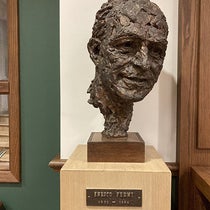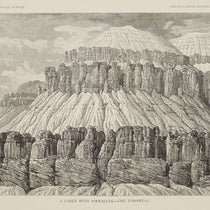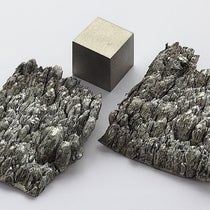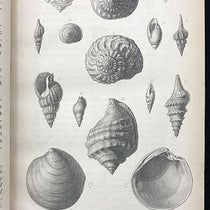Scientist of the Day - Clarence Dutton
Clarence Edward Dutton, an American geologist and writer, was born in Connecticut on May 15, 1841. He attended Yale College, served in the Civil War, and afterwards learned geology from James Hall of the New York Geological Survey. In 1875, he started working for John Wesley Powell, who had been exploring the Colorado River and the High Plateau of Colorado. When Powell became director of the U.S. Geological Survey in 1879, Dutton went with him.
Powell had published a book about running the Colorado River, but he hadn't found the time to write a geological account of the Colorado River basin, especially the Grand Canyon, so he turned that over to Dutton. Dutton did further exploring on his own, and he took along with him the artists William Henry Holmes and Thomas Moran, and photographer Jack Hillers. In 1882, Dutton published the Tertiary History of the Grand Cañon District, consisting of a quarto text volume and a folio Atlas. The set is certainly the prime candidate for the title: the most beautiful geology book ever to appear in print.
It is the Atlas that grabs most viewers' attention, with its double page chromolithographs of the Grand Canyon. One group of three prints, called “Panorama from Point Sublime,” is especially impressive. We showed two of them in an earlier post on Dutton, and all three in an even earlier post on Holmes, and you can see print versions of these if you subscribe to our library's house magazine, the Hedgehog, where an article on the Atlas was the cover story for the 2024 issue (no. 69).
Today we would like to point out that the text volume should not be ignored by fans of the Atlas, Dutton, Holmes, or Moran. It contains quite a few images of its own, in a variety of formats: wood engravings, photogravures, and lithographs. They are not as breathtaking as the�” Panorama from Point Sublime,” but I find them to be just as attractive. Most are based on sketches by Holmes. One of my favorites is the lead image here, "A Gable with Pinnacles," a wood engraving after a Holmes drawing (first image). I also like the single-sheet panorama, showing the Vermilion Cliffs (sixth image). These double plates, being large, contain exquisite detail, which I try to partially convey with a detail of the far-away cliffs (seventh image).
The other reason for focusing on the text volume here is to remind us all that Dutton was a master of descriptive prose. No geologist felt the presence of the Sublime in Nature quite so much as Dutton, or expressed it quite so well. We show you the opening paragraph of Dutton’s chapter on Point Sublime (eighth image), and he doesn’t get much of a chance to blow you away in one paragraph, but give him a few pages, and he will. You can find our entire text volume online here (and the online Atlas here)
In the chapter on Point Sublime, there are three smaller versions of the three Panorama lithographs in the Atlas, these uncolored, but serving as keys to the geological features in the colored views. We show here the first of the three text-volume plates, the one called “Looking East,” which contains the two tiny figures of Dutton and Holmes. We showed a detail of the colored version as the last image in our first post on Dutton. No one can quite figure out which is which, although we usually assume that Dutton is the one standing behind.
We have two copies of Dutton's Tertiary History in our library, one in the History of Science collection, the other in our Government Documents collection. The latter is the one we have digitized, but I prefer the other one. Be sure to look at both if you come to visit.
William B. Ashworth, Jr., Consultant for the History of Science, Linda Hall Library and Associate Professor emeritus, Department of History, University of Missouri-Kansas City. Comments or corrections are welcome; please direct to ashworthw@umkc.edu.















